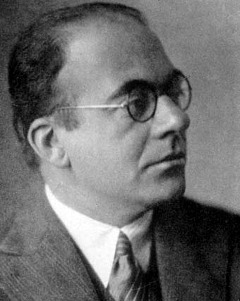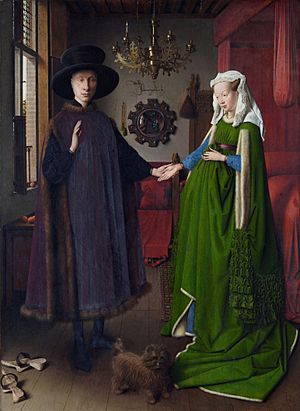Erwin Panofsky facts for kids
Quick facts for kids
Erwin Panofsky
|
|
|---|---|

Panofsky in the 1920s
|
|
| Born | March 30, 1892 Hannover, Germany
|
| Died | March 14, 1968 (aged 75) |
Erwin Panofsky (born March 30, 1892, died March 14, 1968) was a famous art historian. He was born in Germany, but he moved to the United States. He spent most of his career there after the Nazi government came to power in Germany.
Panofsky was very important in studying iconography. This is the study of symbols and meanings in art. His ideas changed how people understood artworks, especially from the Renaissance. He wrote many important books that are still read today. These include Renaissance and Renascences in Western Art and Early Netherlandish Painting.
About Erwin Panofsky
Panofsky was born in Hannover, Germany. His family was wealthy and Jewish. He grew up in Berlin and studied many subjects, including art history. He went to universities in Freiburg, Munich, and Berlin.
In 1914, he finished his main university degree. His topic was about the art ideas of Albrecht Dürer, a famous German artist. Panofsky did not fight in World War I because of a horse-riding accident. This allowed him to keep studying art history.
Panofsky taught at several universities in Germany. From 1920 to 1933, he taught at the University of Hamburg. During this time, he started writing his most important books about art history. One key early work was Idea: A Concept in Art Theory.
Moving to the United States
In 1931, Panofsky first came to the United States to teach at New York University. At first, he split his time between Hamburg and New York. But when the Nazis took control in Germany, he lost his job in Hamburg because he was Jewish.
So, Panofsky and his wife, Dorothea "Dora" Mosse, stayed in the United States permanently. In 1935, he joined the Institute for Advanced Study in Princeton, New Jersey. He worked there for the rest of his life. A street in Princeton, "Panofsky Lane," was later named after him.
Panofsky was friends with famous scientists like Wolfgang Pauli and Albert Einstein. His younger son, Wolfgang K. H. Panofsky, became a well-known physicist. His older son, Hans A. Panofsky, studied weather and the atmosphere.
Understanding Art: Iconology
Panofsky is best known for his work in iconology. This is a special way of studying art history. It was developed by Aby Warburg and his students. Iconology helps us understand the deeper meanings and symbols in artworks. Panofsky worked closely with his friend Fritz Saxl on many projects.
In 1939, Panofsky wrote an article called "Iconography and Iconology." In it, he explained his method for understanding art.
Art and Movies
Panofsky also wrote about movies! In his 1936 essay, "Style and Medium in the Motion Pictures", he looked at how movies tell stories. He explored the special ways that film uses pictures and movement to create meaning.
Three Levels of Meaning in Art

In his book Studies in Iconology, Panofsky explained that we can understand art in three main ways:
- First Level: What you see directly. This is the most basic understanding. Imagine a painting of 13 men sitting around a table. At this level, you just see 13 men and a table. You don't add any special knowledge yet.
- Second Level: What symbols mean. This level adds cultural knowledge. If you see 13 men at a table, and you know about Christianity, you might realize it's The Last Supper. Or, if you see a man with a halo and a lion, you might know it's St. Mark. This level uses common symbols and stories.
- Third Level: The deeper, hidden meaning. This is the most complex level. It looks at why the artist chose to paint something in a certain way. It considers the artist's life, the time period, and the culture. For example, why was The Last Supper painted that way? Or why was St. Mark so important to the person who paid for the artwork? This level tries to understand the whole story behind the art.
Panofsky believed that to truly understand Renaissance art, you needed to look at all three levels. He thought that art was a very smart way for people to express ideas.
Famous Art Interpretations
Panofsky was famous for finding "hidden symbols" in art. For example, he studied Jan van Eyck's Arnolfini Portrait. He suggested that it wasn't just a picture of a wedding. He thought it was like a visual contract, showing the marriage agreement. He found many small details in the painting that pointed to the idea of marriage.
He also studied the prints of Albrecht Dürer, like Knight, Death, and the Devil and Melancolia I. Panofsky gave deep explanations of the symbols in these artworks.
Panofsky's Lost Manuscript
In 2012, an important old manuscript by Panofsky was found. It was his 1920 work about the art principles of Michelangelo and Raphael. People thought this manuscript was lost during World War II. It was found in an old Nazi safe in Munich, Germany.
This discovery was very exciting for art historians. In 2016, a special professorship, the Panofsky-Professur, was created in his honor in Munich.
Influence on Other Thinkers
Panofsky's ideas also influenced other important thinkers. For example, the French sociologist Pierre Bourdieu used Panofsky's ideas about "habitus." This idea helps explain how our background and culture shape our tastes and actions. Bourdieu even translated one of Panofsky's books into French.
Main Books by Panofsky
- Idea: A Concept in Art Theory (1924)
- Perspective as Symbolic Form (1927)
- Studies in Iconology (1939)
- The Life and Art of Albrecht Dürer (1943)
- Gothic Architecture and Scholasticism (1951)
- Early Netherlandish Painting: Its Origins and Character (1953)
- Meaning in the Visual Arts (1955)
- Pandora's Box: the Changing Aspects of a Mythical Symbol (1956) (with Dora Panofsky)
- Renaissance and Renascences in Western Art (1960)
- Tomb Sculpture: Four Lectures on Its Changing Aspects from Ancient Egypt to Bernini (1964)
Images for kids
See also
 In Spanish: Erwin Panofsky para niños
In Spanish: Erwin Panofsky para niños


